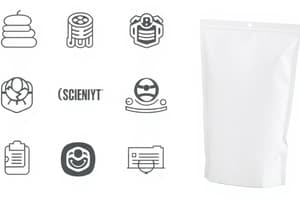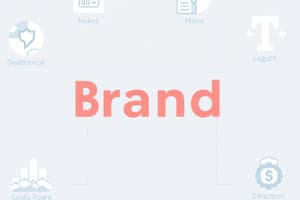Podcast
Questions and Answers
Which naming strategy would likely create a new word that may not have an existing meaning?
Which naming strategy would likely create a new word that may not have an existing meaning?
- Descriptive Names
- Invented Names (correct)
- Geographic Names
- Acronyms
Which logo principle emphasizes the importance of a design that remains effective across various platforms and media?
Which logo principle emphasizes the importance of a design that remains effective across various platforms and media?
- Versatility (correct)
- Timelessness
- Simplicity
- Memorability
What is considered a key characteristic of an effective slogan?
What is considered a key characteristic of an effective slogan?
- Lengthy Descriptions
- Complexity
- Technical Jargon
- Emotional Appeal (correct)
In brand identity development, which aspect focuses on the narrative that conveys the brand's purpose?
In brand identity development, which aspect focuses on the narrative that conveys the brand's purpose?
Which company uses a logo that signifies knowledge and innovation through its simple apple silhouette?
Which company uses a logo that signifies knowledge and innovation through its simple apple silhouette?
What naming strategy does Microsoft utilize in their name creation?
What naming strategy does Microsoft utilize in their name creation?
Which slogan emphasizes the empowerment associated with personal potential?
Which slogan emphasizes the empowerment associated with personal potential?
Which of the following is NOT a principle of effective logo design?
Which of the following is NOT a principle of effective logo design?
Which principle of brand identity development focuses on tailoring the brand to connect with its intended market?
Which principle of brand identity development focuses on tailoring the brand to connect with its intended market?
What color is often associated with trust in logo design?
What color is often associated with trust in logo design?
Flashcards are hidden until you start studying
Study Notes
Company Naming Strategies
- Descriptive Names: Clearly convey what the company does (e.g., "Cloud Solutions").
- Acronyms: Use initials that may be easier to remember (e.g., IBM - International Business Machines).
- Invented Names: Create entirely new words (e.g., "Google").
- Metaphoric Names: Use metaphors to evoke ideas or feelings (e.g., "Apple" for innovation).
- Geographic Names: Incorporate a location (e.g., "California Software").
- Personification: Using a person's name or an imaginary character (e.g., "Hewlett-Packard").
Logo Design Principles
- Simplicity: A simple logo is memorable and easily recognizable.
- Versatility: Logos should work in various sizes and mediums (print, digital).
- Relevance: The logo should reflect the brand's identity and values.
- Timelessness: Avoid trends; aim for a design that lasts over time.
- Memorability: A strong logo should be easy to remember.
- Color Psychology: Use colors that evoke the desired feelings (e.g., blue for trust).
Effective Slogans
- Brevity: Keep slogans short and punchy (ideally under 10 words).
- Clarity: Clearly communicate the brand's core message or benefit.
- Emotional Appeal: Use emotional language to connect with the audience.
- Unique Selling Proposition (USP): Highlight what makes the brand different.
- Rhythm and Rhyme: Employ rhythmic or rhyming elements for memorability.
Brand Identity Development
- Consistent Messaging: Ensure all communications reflect the brand's voice.
- Visual Elements: Define color schemes, typography, and imagery that represent the brand.
- Target Audience: Understand and tailor the brand identity to resonate with the intended audience.
- Brand Story: Create a narrative that communicates the brand's purpose and values.
- Engagement: Foster a relationship with consumers through social media and community involvement.
Case Studies Of Successful IT Brands
-
Apple Inc.
- Name: Evokes simplicity and approachability.
- Logo: Simple apple silhouette, symbolizes knowledge and innovation.
- Slogan: "Think Different" - stresses creativity and innovation.
-
Microsoft
- Name: Combines "microcomputer" and "software."
- Logo: Uses colored squares, reflects diversity in products.
- Slogan: "Your potential, our passion" - emphasizes empowerment.
-
Google
- Name: Derived from "googol," indicating vastness of information.
- Logo: Simple, colorful, easy to recognize.
- Slogan: "Don't be evil" - emphasizes ethical practices.
-
IBM
- Name: Descriptive and professional.
- Logo: Bold, solid lines, suggests strength and reliability.
- Slogan: "Think" - encourages innovation and thought leadership.
-
Adobe
- Name: Named after a river, evokes creativity and nature.
- Logo: Simple, stylized "A" that is modern and recognizable.
- Slogan: "Creativity for all" - emphasizes accessibility in design.
Company Naming Strategies
- Descriptive Names: Clearly articulate the company's function or service, aiding consumer recognition (e.g., "Cloud Solutions").
- Acronyms: Utilize initials for memorable branding, simplifying complex names (e.g., IBM for International Business Machines).
- Invented Names: Formulate new, distinctive words that can become iconic (e.g., "Google").
- Metaphoric Names: Employ metaphors that resonate emotionally or conceptually with consumers (e.g., "Apple" as a symbol of innovation).
- Geographic Names: Incorporate geographical identifiers to suggest locality or origin (e.g., "California Software").
- Personification: Utilize personal names or fictional characters to humanize the brand (e.g., "Hewlett-Packard").
Logo Design Principles
- Simplicity: Create uncomplicated logos that enhance memorability and recognition.
- Versatility: Ensure the logo maintains clarity and impact across different platforms and sizes.
- Relevance: Align the logo design with the brand's core identity and values for consistency.
- Timelessness: Design logos that avoid fleeting trends, focusing on longevity.
- Memorability: Develop strong logos that are easily recalled by consumers.
- Color Psychology: Leverage colors to invoke specific emotions or perceptions (e.g., blue associated with trustworthiness).
Effective Slogans
- Brevity: Craft short and impactful slogans, ideally limited to ten words for quick recall.
- Clarity: Communicate the brand's essential message or advantages clearly.
- Emotional Appeal: Integrate emotional language to strengthen connections with the audience.
- Unique Selling Proposition (USP): Emphasize distinctive qualities that set the brand apart from competitors.
- Rhythm and Rhyme: Implement rhythmic or rhyming phrases to enhance memorability.
Brand Identity Development
- Consistent Messaging: Ensure all brand communications reflect a cohesive voice and style.
- Visual Elements: Define comprehensive visual guidelines including color palette, typography, and imagery.
- Target Audience: Analyze and tailor brand messaging to appeal specifically to desired consumer groups.
- Brand Story: Develop a narrative that conveys the brand's mission and values effectively.
- Engagement: Build relationships with consumers through social media interaction and active community involvement.
Case Studies Of Successful IT Brands
-
Apple Inc.
- Name: Conveys simplicity and accessibility.
- Logo: Features a minimalist apple silhouette, representing knowledge and innovation.
- Slogan: "Think Different" emphasizes creativity and forward-thinking.
-
Microsoft
- Name: A blend of "microcomputer" and "software," clearly defining its market.
- Logo: Composed of colored squares, showcasing product diversity.
- Slogan: "Your potential, our passion" focuses on customer empowerment.
-
Google
- Name: Derived from "googol," symbolizing vast information availability.
- Logo: Simple and colorful, ensuring ease of recognition.
- Slogan: "Don't be evil" highlights the company’s commitment to ethical practices.
-
IBM
- Name: Descriptive and professional, indicative of technological expertise.
- Logo: Features bold, solid lines suggesting strength and dependability.
- Slogan: "Think" inspires innovation and encourages thought leadership.
-
Adobe
- Name: Named after a river, linking creativity to nature.
- Logo: Stylized "A," modern and recognizable.
- Slogan: "Creativity for all" underscores accessibility in design tools.
Studying That Suits You
Use AI to generate personalized quizzes and flashcards to suit your learning preferences.




